Health matters: preventing infections and reducing antimicrobial resistance
Published 13 November 2017
Summary
This professional resource outlines the importance of infection prevention and control and how it can contribute to reducing antimicrobial resistance.
Scale of the problem
Preventing infections from occurring in the first place is one of the best ways to reduce the need to prescribe antibiotics and prevent antimicrobial resistance (AMR). AMR can be developed in bacteria, viruses, fungi and parasites that cause infection, making them resistant to treatment. Every infection prevented reduces the need for and use of antimicrobials, which in turn lessens the potential for development of resistance.
Antibiotics are by far the most widely prescribed antimicrobial agents. Unlike many other drugs used in medicine, the more we use antibiotics the less effective they become against their target organisms. With antibiotics, overuse or inappropriate use allows bacteria to develop resistance which can lead to infections that are increasingly difficult to treat.
A failure to address the challenge of antimicrobial resistance could result in:
- an estimated 10 million deaths every year globally by 2050
- a cost of £66 trillion in lost productivity to the global economy
The latest English surveillance programme for antimicrobial utilisation and resistance (ESPAUR) report found that total consumption of antibiotics in England has declined by 5.1% over the last 5 years. However, the burden of infections caused by antibiotic-resistant continues to rise, highlighting the necessity for effective prevention.
Currently in the UK, the greatest and increasing threat from drug resistant organisms is from Gram-negative bacteria, named so because the cell envelope that surrounds them does not retain a staining dye. The complex chemical structure of this envelope makes it difficult for large molecules to get into bacterial cell. This makes it harder to find new antibiotics that will work against these bacteria.
Gram-negative organisms are most commonly found in healthy individuals but can also cause significant illness and death in some instances. They can cause infections in many organ systems but are particularly dangerous when they infect the blood and cause sepsis, a potentially catastrophic systemic infection.
Infections caused by Gram-negative organisms are increasing. The key bacteria causing increasing numbers of infections are:
- Escherichia coli
- Klebsiella pneumoniae
- Pseudomonas aeruginosa
These 3 organisms account for 72% of all Gram-negative blood stream infections (BSIs).
E. coli is the most commonly seen Gram-negative BSI and now accounts for 55% of all Gram-negative BSIs.
A total of 40,580 cases of E. coli BSI were reported by NHS trusts in England between 1 April 2016 and 31 March 2017. This is an increase of 6.1% from 2015 to 16 (n = 38,251), and an increase of 25.6% from 2012 to 13 (n = 32,309).
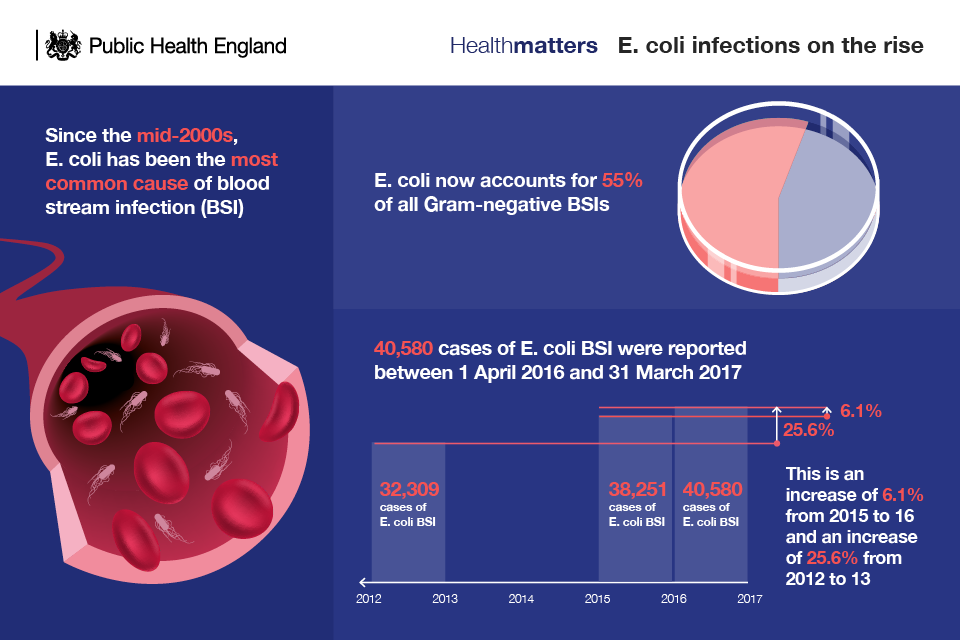
The government has acknowledged the need for action and in November 2016 set out an ambitions to reduce healthcare associated Gram-negative BSIs by 50% by 2021 and reduce inappropriate antimicrobial prescribing by 50% by 2021.
To achieve these ambitions, we need to have effective wide-reaching infection prevention and control measures but must also target the most problematic resistant organisms, focusing resources and expertise. We have seen the progress made in the last decade by targeting the spread of certain micro-organisms, notably meticillin-resistant Staphylococcus aureus (MRSA) and Clostridium difficile which have been reduced from their peak levels by 90% and 75%, respectively. For 2017 to 18 the plan is to maintain that progress and have the additional ambition of reducing healthcare-associated E. coli bloodstream infections.
A Quality Premium, from April 2017 for 2 years, is in place for clinical commissioning groups (CCGs) to reduce all E. coli BSIs by 10% in Year 1.
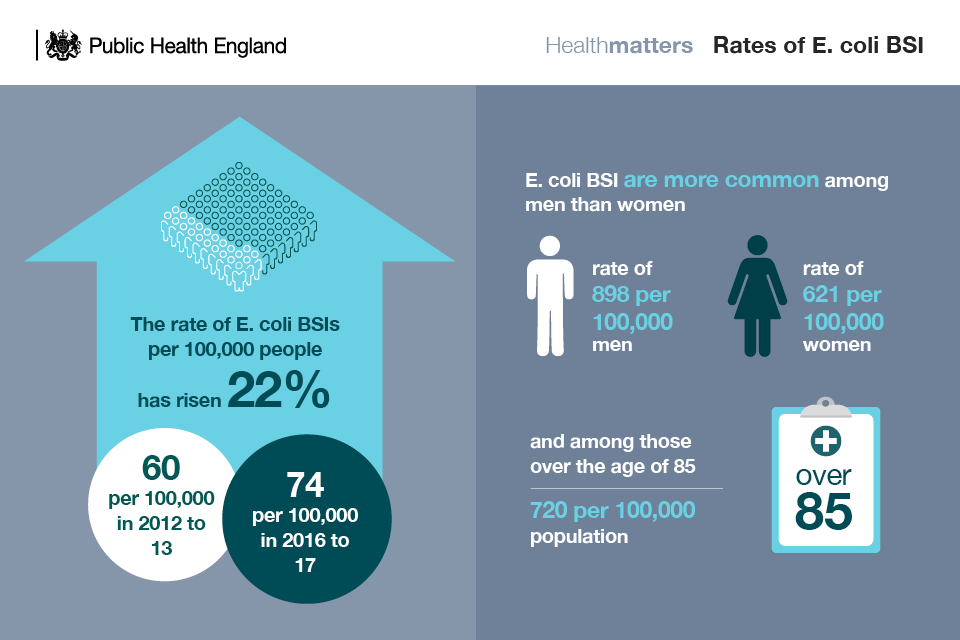

Prevention using the chain of infection model
Comprehensive infection prevention and control measures are the cornerstone of any approach to reduce the development and spread of antimicrobial-resistant infections. To ensure all opportunities to inhibit spread of infection are addressed it is useful to model the process required for a microorganism to cause an infection.

There are certain conditions that need to be met for a microorganism to spread and potentially lead to an infection. In most instances, there is an interaction between the microorganism, host and environment that leads to the organism multiplying and causing harm in the form of an infection in an area of the body in which it is not normally present.
The microorganism leaves the colony in which it normally resides, the reservoir, through a way out, the portal of exit, for example in faeces. It is transferred via a mode of transmission, for example hands, and enters through a portal of entry, such as the urethra, to form a new colony. Once established, this new colony may become a new focus of infection and another reservoir. This cyclical process is known as the chain of infection.
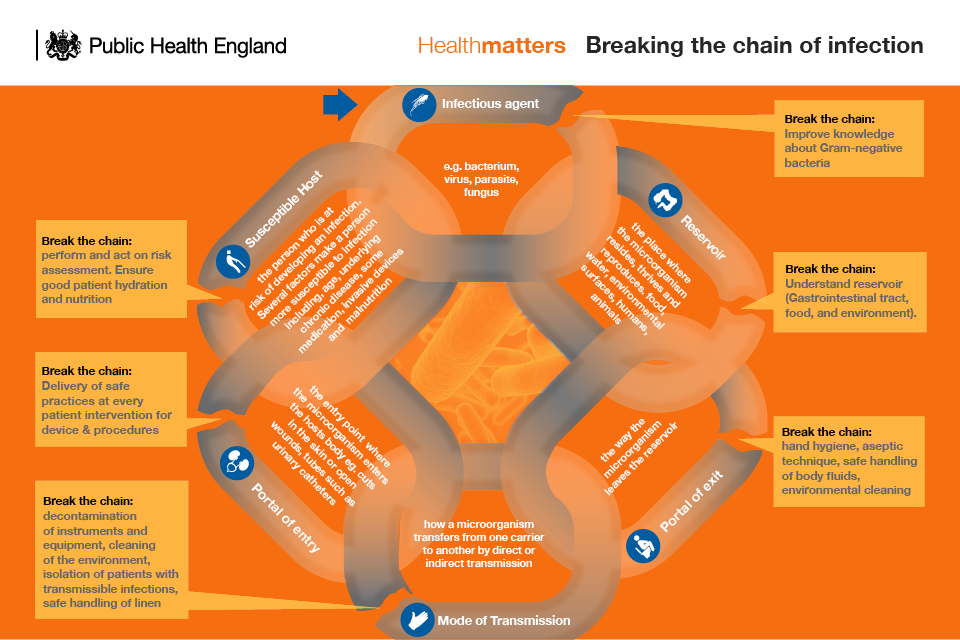
During this process, the organism can pass from one host to cause infection in another host, referred to as exogenous origin, or can transfer within the host to cause an infection elsewhere in the body, referred to as endogenous infection. A large proportion of Gram-negative infections are caused by endogenous organisms where the bacteria are moving within the same host from the reservoir, such as the gut, where it may normally reside, to cause an infection elsewhere, for instance in the urinary tract. These organisms can then travel on potentially causing blood stream infections.
Each step represents a link in this chain and if all the links in the chain are present, an infection develops. If one or more links are broken, the infection will be prevented. Infection prevention and control (IPC) programmes often use this model and apply it to specific organisms or environments so that targeted measures can be introduced and the spread of infection halted.
The World Health Organisation has outlined the core components that should make up IPC programmes. All core components should be considered equally important and crucial for the establishment and effective functioning of IPC programmes and practices.

In England, the Health and Social Care Act 2008 Code of Practice on the prevention and control of infections and related guidance applies to all registered providers of healthcare and adult social care in England. The Code of Practice sets out the 10 criteria against which the Care Quality Commission (CQC) will assess a registered provider on whether it complies with the requirements which are set out in these regulations.
There are also a number of evidence based guidelines to assist providers of healthcare in their delivery of good IPC programmes. The PHE AMR Resource Handbook provides a compilation of the relevant guidelines for the prevention of infection and AMR resistance. The NHS Improvement hub, co-produced with PHE and health care workers across the system provides further resources to support those working in health and social care deliver the ambition to reduce Gram-negative BSIs.
Health and social care workers play a vital role in breaking the chain of infection. They are in contact with individuals receiving health and social care throughout the day and have the opportunity to prevent infections at every contact and intervention.
Infectious agent
Infectious agents include a wide variety of causative organisms including viruses, such as influenza and bacteria, such as MRSA, E. coli, and C. difficile. Understanding the biological properties of the organisms, for instance the conditions in which they reproduce, ensures that the measures aimed at prevent their spread are targeted and effective.
Examples of actions to break the chain:
- improving knowledge of microorganisms and the infections they cause
- know your local surveillance data using PHE’s fingertips and the risk factors and reasons patients in your population are getting infections
- know what steps you need to take in preventing patients getting infections and preventing onward transmission
Reservoir
This is the place where the microorganism normally lives, grows and multiplies. The reservoir harbours the infectious microorganism and serves as a source of infection. This could be in humans, animals, food, water, or the environment including environmental surfaces. E. coli, for example, is most commonly found in the lower intestine of warm-blooded animals, including humans. Under normal circumstances they do not cause us harm and are a natural part of our gut microbiome.
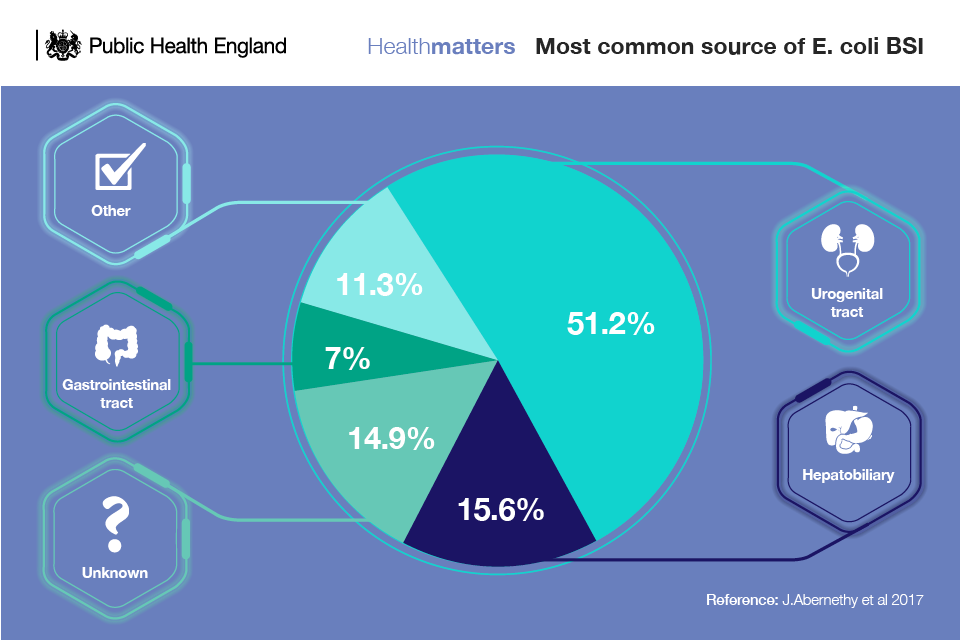
When people take antibiotics, this contributes to the colonisation of resistant organisms in the gut biome by eliminating susceptible competitive organisms, reducing diversity and allowing the proliferation of the resistant organisms.
Examples of actions to break the chain:
- understand where microorganisms reside as this is an important first step in understanding how to break the chain of infection
- actively promote antimicrobial stewardship to reduce inappropriate prescribing, which will in turn help preserve the gut microbiome
- ensure all clinically important cases of resistant organisms are reported to surveillance teams
In theory, identifying patients who carry reservoirs of dangerous organisms, such as E. coli, and decolonising them would seem like an effective prevention measure. However in most cases that would do more harm than good in the damage it would cause to the natural biome and may worsen bacterial resistance. We currently only screen high risk patients for some organisms such as MRSA and CPE (Carbapenemase-Producing Enterobacteriaceae) so carriers can be appropriately isolated with IPC precautions or decolonised (recommended in certain cases of MRSA colonisation).
Healthcare workers are expected to be up to date with all recommended vaccinations. For example, ensuring healthcare workers are vaccinated against the influenza virus is important for protecting vulnerable patients against influenza and the complications associated with secondary bacterial infections that then may require antibiotics.
Portal of exit
The portal of exit is the path by which the microorganism leaves the reservoir. This could be the mouth or nose during coughing, sneezing, talking or breathing, skin, gastrointestinal tract through stool or vomit, urine, blood and other body fluids such as wound drainage.
Examples of actions to break the chain:
Prevent contamination of the environment with gut organisms where E. coli may reside by:
- handling and disposing of body fluids properly and using personal protective equipment like gloves, gown and mask if appropriate
- cleaning any spillage safely to prevent onward transmission
- performing hand hygiene and following the WHO five moments of hand hygiene
- environmental cleaning
- ensuring reusable instruments and equipment are appropriately decontaminated, for example, endoscopes
Protect skin lesions or wounds from contamination by:
- applying aseptic technique for all dressings
- disposing of wound dressing safely
- using personal protective equipment (PPE), such as gloves, gowns, respiratory protection, eye protection, when appropriate
- performing hand hygiene
Prevent contamination from urinary tract and gastrointestinal tract by:
- safely handling body fluids
- cleaning any spillage
- performing hand hygiene
Prevent contamination from the respiratory tract by:
- adhering to respiratory etiquette - cover the nose and mouth when coughing or sneezing and perform hand hygiene
- ensuring vaccinations are up to date
Prevent transmission from blood and bodily fluids by:
- wearing appropriate PPE when handling blood and bodily fluids
- safe handling and disposal of sharps
Mode of transmission
The mode of transmission is the way that a microorganism is transmitted from the reservoir to the site of infection. This can be via direct or indirect transmission.
Examples of actions to break the chain:
- hand hygiene
- wearing personal protective equipment appropriately
- decontamination of instruments and equipment in-between patient use
- decontamination of surgical instruments and other reusable medical devices
- cleaning of the environment
- isolation of patients with multi drug resistant E.coli or those patients with diarrhoea
- safe handling of food and water
- safe handling and decontamination of linen
- safe handling and disposal of sharps
Portal of entry
The entry point is where the microorganism enters the site of infection in the host and is able to multiply or cause harm.
Examples of actions to break the chain:
Catheter insertion and care
- urinary catheters allow bacteria to enter the bladder where they may cause infection - only insert urinary catheters when absolutely essential and exclude any alternatives first, before considering catheterisation; a bladder scanner should be used to aid the decision
- hydration should be checked and recorded
- record insertion, expected date of removal and justification for insertion in all health and social care notes
- record continued need for catheterisation
- patients managing own catheter should receive training in asepsis and care of catheter
Chronic wounds
- wounds (breaks in the skin) allow bacteria to enter the body - use aseptic technique for wound care to minimise the risk of this happening
- follow local wound formulary
- assess as per policy at every dressing change and document
- wound swabs should only be taken when there are signs and symptoms of an infection or absence of healing
Personal hygiene
- support patients so they have access to good personal hygiene particularly if they have diarrhoea, incontinence or physical needs that make access to personal hygiene more difficult
Susceptible host
The susceptible host is the individual who is at risk of developing an infection. Several factors make a person more susceptible to infection depending on genetic or constitutional factors, specific immunity and non-specific factors. Factors that increase the host’s susceptibility, by disrupting the ability of the host to defend against the organism, include malnutrition, alcoholism and disease or treatment that impairs the nonspecific immune response.
It remains vital that patients are addressed holistically to maximise the protection they are afforded by their natural barriers to infection and immune system. For instance, taking steps to improve the blood sugar control of someone with diabetes will decrease the chances of them contracting an infection.
Independent factors that predict 30 day mortality from E. coli BSI are:
- age - being under 1-year-old or over 44 years carries a 3-fold risk whereas being over-85 is the most significant risk factor of all with a 6-fold increase
- patient having a respiratory focus of E.coli infection or a patient where an underlying focus is unknown - a bacteraemia as a result of these foci may indicate a background of more severe illness than those patients with an E. coli BSI related to a UTI
- hospital onset infection - positive blood sample taken more than 2 days after admission
- not being admitted to hospital
- patient with E. coli bacteraemia that was non-susceptible to ciprofloxacin
- winter onset
- male gender
It is notable how many of these factors are non-modifiable which again emphasises the importance of effective prevention of infection. However if an infection has established within a host, it is vital to diagnose and treat it as soon as possible to prevent spread, particularly into the blood. In the case of E. coli BSIs, the most common source of infection is the urogenital tract which accounts for 51.2% of cases. Factors that increase the risk of such infections taking hold, such as urinary catheterisation, should be addressed and minimised.
Examples of actions to break the chain:
- identify any underlying risks a patient may have that may lead to an infection and where possible address those risks
- identify whether the patient has a UTI
PHE has produced guidance on diagnosing UTIs in primary care. The National Institute for Health and Care Excellence (NICE) has produced guidance on managing UTIs in adults.
Preventing UTIs in the community through good hydration is important.
Catheter-associated UTIs comprise a large proportion of healthcare-associated infections and can occur whether a person has a short-term or a long-term catheter. There is a strong association between duration of urinary catheterisation and risk of infection, and catheters are sometimes inserted inappropriately or there is a delay in removing them.
Health professionals should always question whether the catheter is needed and consider other options. If a catheter is essential, ensure aseptic technique is followed and the catheter is cared for and review whether it is needed every day. NICE has recommendations on preventing infection related to long-term urinary catheters, as part of its guidance on infection prevention and control.
Call to action
Bugs don’t differentiate between primary and secondary care or between hospitals and the community, yet most of the IPC focus to date has been in hospitals. It is time to move to a whole health system approach that spans health sector boundaries and looks at the whole patient pathway.
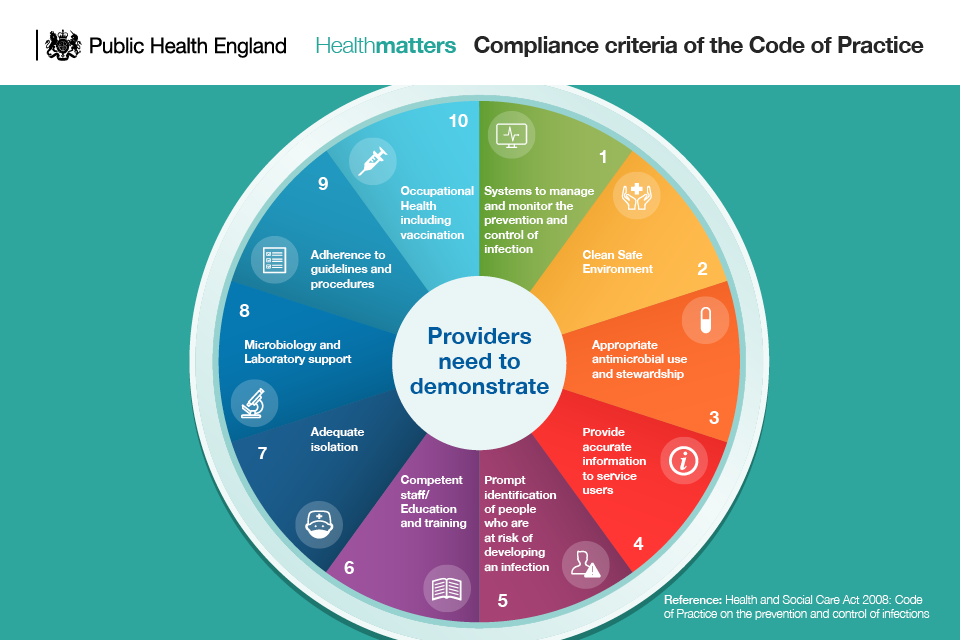
Actions for the whole health and social care system
- ensure there is a whole cross-system health and social care group with all sectors present
- understand what is causing healthcare-associated infections such as E. coli BSI in your patients
- develop a plan together to reduce these infections
Board and senior leadership
- board level assurance that as a registered provider, there is evidence of compliance with the Health and Social Care Act Code of Practice on the prevention and control of infections and related guidance
- ensure adequate investment in leadership of IPC, for example having a director of IPC
- staff training and education to implement effective, targeted programmes
- ensure there is evidence in place that there are adequate educational resources and training in IPC and ensure skills are regularly reviewed
Community care professionals
- ensure you have a good understanding of the chain of infection and your role in breaking the chain so that your patients are less likely to acquire an infection from healthcare interventions
- prevent infections by ensuring your hands, instruments and environment are kept clean
- ensure best practice is observed when attending to wounds and urinary catheters - aseptic technique, hand hygiene
- if a patient has a urinary catheter, ask yourself if they need it and take action if they don’t
Healthcare professionals (primary and secondary)
- ensure you have a good understanding of the chain of infection and your role in breaking the chain so that your patients are less likely to acquire an infection from healthcare interventions
- prevent infections by ensuring your hands, instruments and environment are kept clean
- ensure best practice is observed when attending to wounds and urinary catheters - aseptic technique, hand hygiene
- if a patient has a urinary catheter, ask yourself if they need it and take action if they don’t
- talk to your patients about taking antibiotics appropriately and the dangers of misuse.
- talk to your patients about preventing infections, such as sexual health or encouraging adequate hydration in patient groups at high risk of UTI
Specialist IPC teams
- ensure compliance with the Health and Social Care Act Code of Practice on the prevention and control of infections and related guidance
- ensure compliance with evidence based guidelines within the setting - Epic3, NICE
- establish a good surveillance programme in order to understand the risk factors and epidemiology of the infections in your setting
- implement antibiotic stewardship with education and guidance to minimise inappropriate antibiotic use
Antibiotic Guardian

All professionals can sign up to become an Antibiotic Guardian by choosing pledges on how they can personally help contribute to tackling AMR on the website. These are designed to make professionals as well as the public think about how they can make better use of antibiotics and personally contribute to tackling AMR, be it through having meaningful conversations with patients or educating family members on the risks AMR poses. Evaluation of the programme has shown that those who become an Antibiotic Guardian show increased commitment to tackling AMR, and increased self reported behaviour change and knowledge.
Resources
Download the Health matters infographics.
Read the Health matters blog.
Watch Health matters videos.
Read the case study: Reducing catheter-associated UTI rates in hospital .
Read the case study: Improving UTI management in the community.
